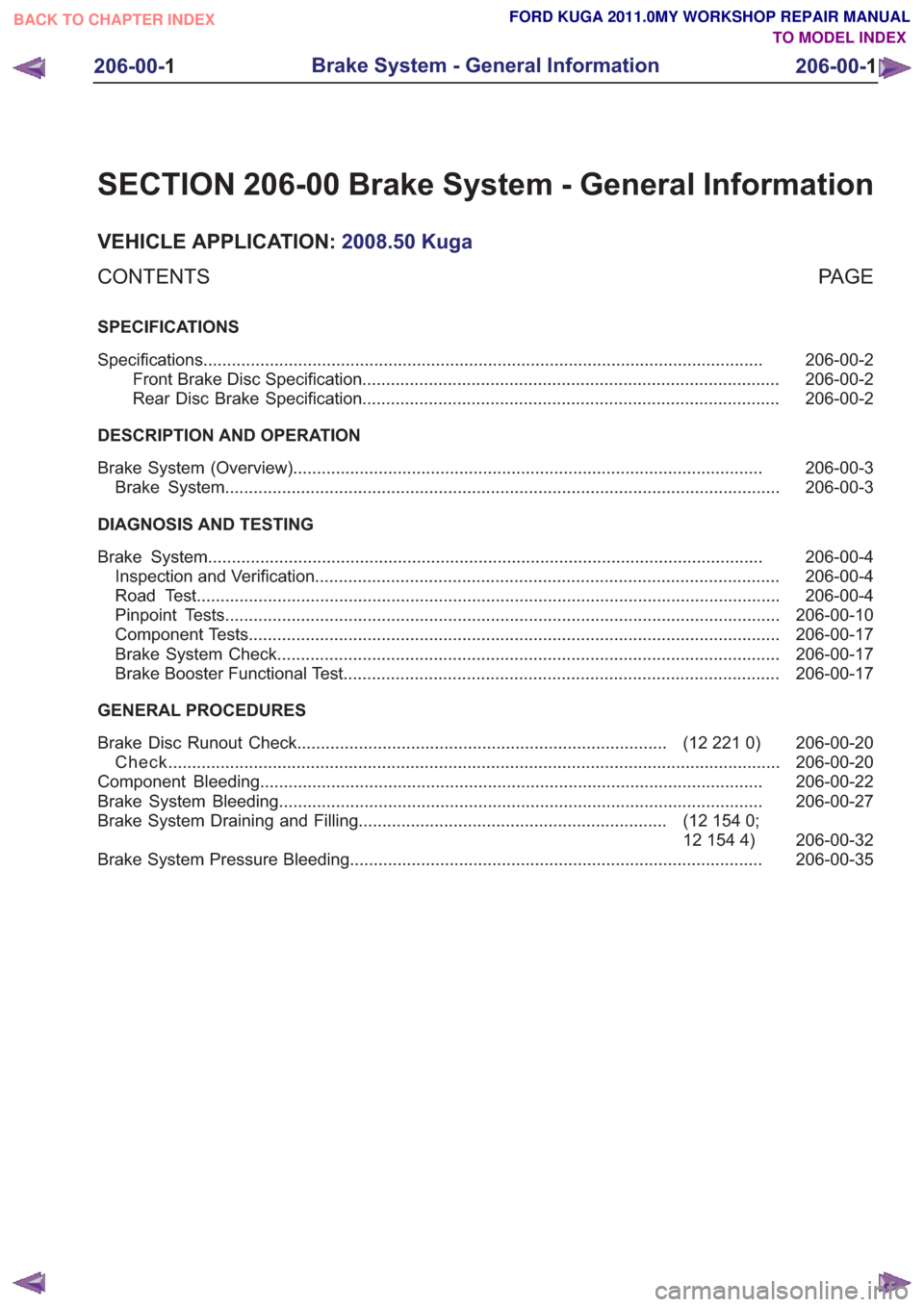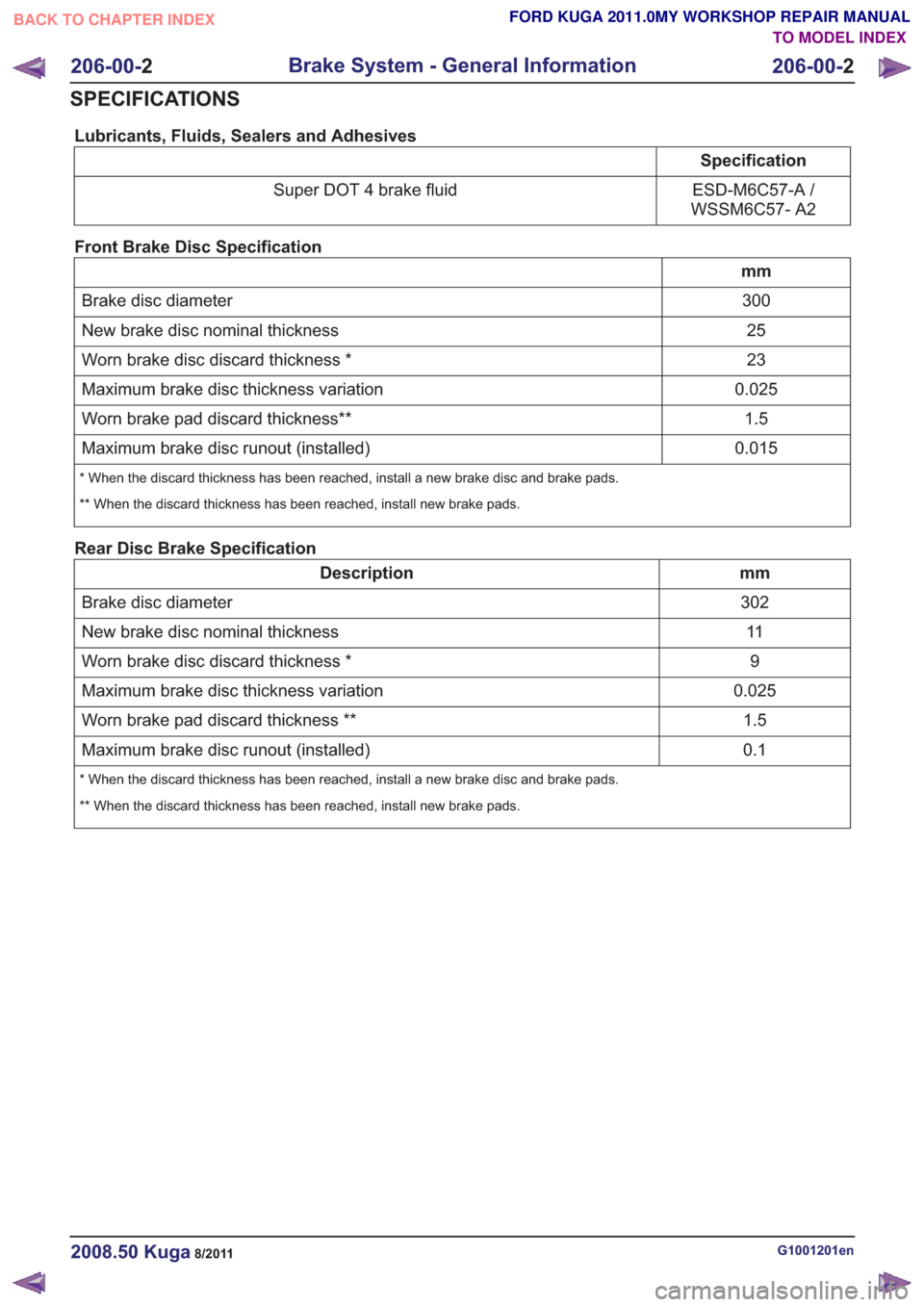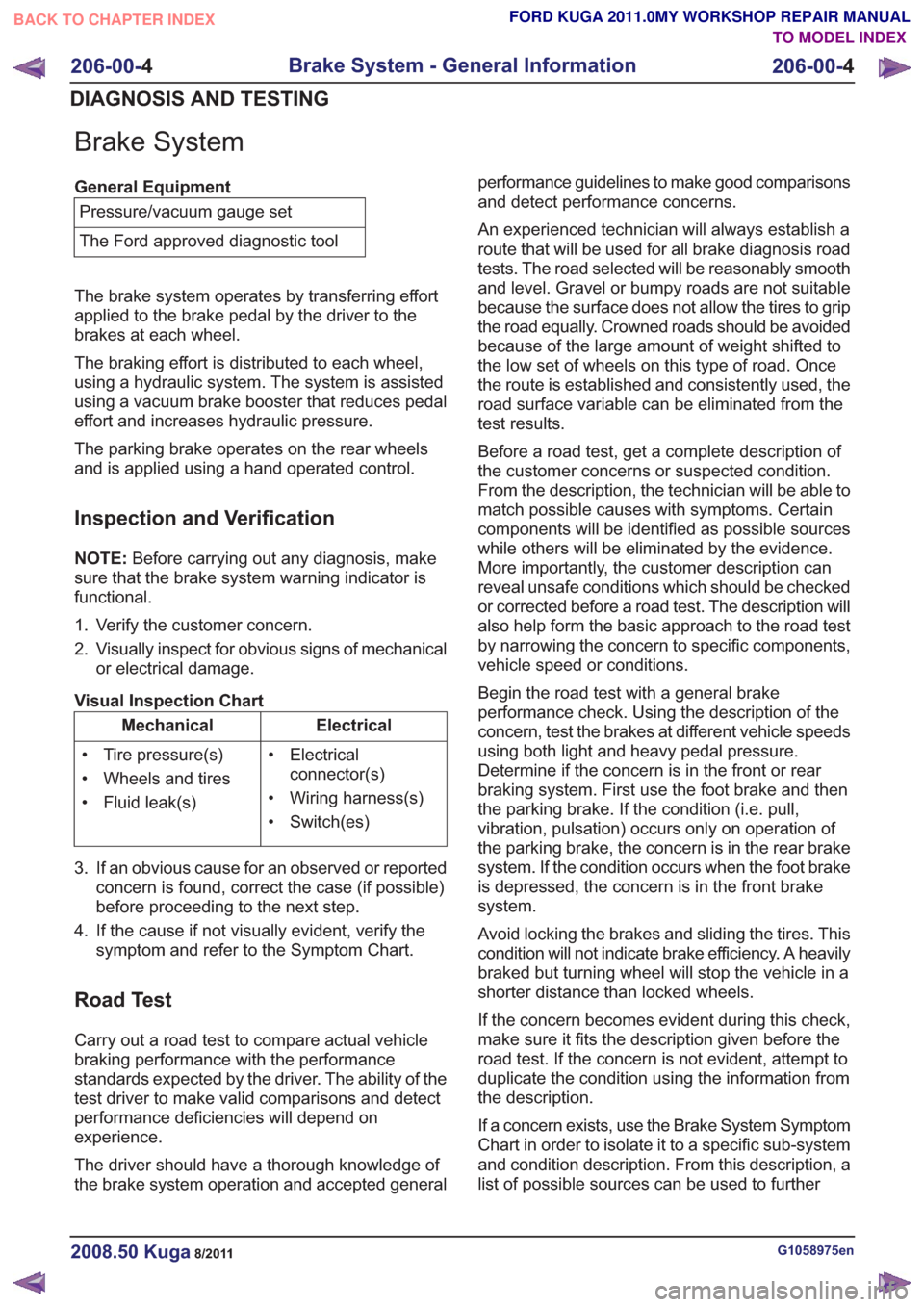Page 1333 of 2057
Installation
1.On both sides.
E101644
2.On both sides.
Torque: 1
15Nm
E101643
3. NOTE: Only tighten the bolt finger tight at this
stage.
On both sides.
E101641
4. Fabricate a spacer.
E69209
226
40
5.On both sides.
General Equipment: Transmission Jack
G1058429en2008.50 Kuga8/2011
205-05- 5
Rear Drive Halfshafts
205-05- 5
REMOVAL AND INSTALLATION
TO MODEL INDEX
BACK TO CHAPTER INDEX
FORD KUGA 2011.0MY WORKSHOP REPAIR MANUAL
Page 1334 of 2057
1
2
E93313
6.On both sides.
Torque: 130
Nm
E101642
7.Remove the following items:
1. Spacer
2. General Equipment: Transmission Jack
8. On both sides.
Torque: 5
Nm
E114252
G1058429en2008.50 Kuga8/2011
205-05- 6
Rear Drive Halfshafts
205-05- 6
REMOVAL AND INSTALLATION
TO MODEL INDEX
BACK TO CHAPTER INDEX
FORD KUGA 2011.0MY WORKSHOP REPAIR MANUAL
Page 1335 of 2057
9.On both sides.
Material: Sealant LGN (WSK-M2G349-A8 /
9U7J-M2G349-AA) adhesive
E120924
10. On both sides.
E101640
11 .On both sides.
Torque: 1
10Nm
x4x4
E101639
12.On both sides.
Refer to: Spring(204-02 Rear Suspension,
Removal and Installation).
13. WARNING: Make sure that no load is placed on the brake hose.
On both sides.
Torque: 1
10Nm
x2x2
E101662
14.On both sides.
Material: Sealant LGN (WSK-M2G349-A8 /
9U7J-M2G349-AA) adhesive
Torque: 50
Nm
E101661
G1058429en2008.50 Kuga8/2011
205-05- 7
Rear Drive Halfshafts
205-05- 7
REMOVAL AND INSTALLATION
TO MODEL INDEX
BACK TO CHAPTER INDEX
FORD KUGA 2011.0MY WORKSHOP REPAIR MANUAL
Page 1336 of 2057
15.On both sides.
Refer to: Wheel and Tire (204-04 Wheels and
Tires, Removal and Installation).
16. Refer to: Differential Fluid Level Check (205-02
Rear Drive Axle/Differential, General
Procedures).
G1058429en2008.50 Kuga8/2011
205-05- 8
Rear Drive Halfshafts
205-05- 8
REMOVAL AND INSTALLATION
TO MODEL INDEX
BACK TO CHAPTER INDEX
FORD KUGA 2011.0MY WORKSHOP REPAIR MANUAL
Page 1337 of 2057

SECTION 206-00 Brake System - General Information
VEHICLE APPLICATION:2008.50 Kuga
PA G E
CONTENTS
SPECIFICATIONS
206-00-2
Specifications ........................................................................\
..............................................
206-00-2
Front Brake Disc Specification ........................................................................\
................
206-00-2
Rear Disc Brake Specification ........................................................................\
................
DESCRIPTION AND OPERATION 206-00-3
Brake System (Overview) ........................................................................\
...........................
206-00-3
Brake System ........................................................................\
.............................................
DIAGNOSIS AND TESTING 206-00-4
Brake System ........................................................................\
.............................................
206-00-4
Inspection and Verification ........................................................................\
..........................
206-00-4
Road Test ........................................................................\
...................................................
206-00-10
Pinpoint Tests ........................................................................\
.............................................
206-00-17
Component Tests ........................................................................\
........................................
206-00-17
Brake System Check ........................................................................\
..................................
206-00-17
Brake Booster Functional Test ........................................................................\
....................
GENERAL PROCEDURES 206-00-20
(12 221 0)
Brake Disc Runout Check ........................................................................\
......
206-00-20
Check ........................................................................\
.........................................................
206-00-22
Component Bleeding ........................................................................\
..................................
206-00-27
Brake System Bleeding ........................................................................\
..............................
206-00-32
(12 154 0;
12 154 4)
Brake System Draining and Filling
.................................................................
206-00-35
Brake System Pressure Bleeding ........................................................................\
...............
206-00-1
Brake System - General Information
206-00- 1
.
TO MODEL INDEX
BACK TO CHAPTER INDEX
FORD KUGA 2011.0MY WORKSHOP REPAIR MANUAL
Page 1338 of 2057

Lubricants, Fluids, Sealers and Adhesives
Specification
ESD-M6C57-A /
WSSM6C57- A2
Super DOT 4 brake fluid
Front Brake Disc Specification
mm 300
Brake disc diameter
25
New brake disc nominal thickness
23
Worn brake disc discard thickness *
0.025
Maximum brake disc thickness variation
1.5
Worn brake pad discard thickness**
0.015
Maximum brake disc runout (installed)
* When the discard thickness has been reached, install a new brake disc and brake pads.
** When the discard thickness has been reached, install new brake pads.
Rear Disc Brake Specification
mm
Description
302
Brake disc diameter
11
New brake disc nominal thickness
9
Worn brake disc discard thickness *
0.025
Maximum brake disc thickness variation
1.5
Worn brake pad discard thickness **
0.1
Maximum brake disc runout (installed)
* When the discard thickness has been reached, install a new brake disc and brake pads.
** When the discard thickness has been reached, install new brake pads.
G1001201en2008.50 Kuga8/2011
206-00- 2
Brake System - General Information
206-00- 2
SPECIFICATIONS
TO MODEL INDEX
BACK TO CHAPTER INDEX
FORD KUGA 2011.0MY WORKSHOP REPAIR MANUAL
Page 1339 of 2057
Brake System – Overview
Brake System
E96610
G1001202en2008.50 Kuga8/2011
206-00-3
Brake System - General Information
206-00- 3
DESCRIPTION AND OPERATION
TO MODEL INDEX
BACK TO CHAPTER INDEX
FORD KUGA 2011.0MY WORKSHOP REPAIR MANUAL
Page 1340 of 2057

Brake System
General EquipmentPressure/vacuum gauge set
The Ford approved diagnostic tool
The brake system operates by transferring effort
applied to the brake pedal by the driver to the
brakes at each wheel.
The braking effort is distributed to each wheel,
using a hydraulic system. The system is assisted
using a vacuum brake booster that reduces pedal
effort and increases hydraulic pressure.
The parking brake operates on the rear wheels
and is applied using a hand operated control.
Inspection and Verification
NOTE: Before carrying out any diagnosis, make
sure that the brake system warning indicator is
functional.
1. Verify the customer concern.
2. Visually inspect for obvious signs of mechanical or electrical damage.
Visual Inspection Chart
Electrical
Mechanical
• Electricalconnector(s)
• Wiring harness(s)
• Switch(es)
• Tire pressure(s)
• Wheels and tires
• Fluid leak(s)
3. If an obvious cause for an observed or reported concern is found, correct the case (if possible)
before proceeding to the next step.
4. If the cause if not visually evident, verify the symptom and refer to the Symptom Chart.
Road Test
Carry out a road test to compare actual vehicle
braking performance with the performance
standards expected by the driver. The ability of the
test driver to make valid comparisons and detect
performance deficiencies will depend on
experience.
The driver should have a thorough knowledge of
the brake system operation and accepted general performance guidelines to make good comparisons
and detect performance concerns.
An experienced technician will always establish a
route that will be used for all brake diagnosis road
tests. The road selected will be reasonably smooth
and level. Gravel or bumpy roads are not suitable
because the surface does not allow the tires to grip
the road equally. Crowned roads should be avoided
because of the large amount of weight shifted to
the low set of wheels on this type of road. Once
the route is established and consistently used, the
road surface variable can be eliminated from the
test results.
Before a road test, get a complete description of
the customer concerns or suspected condition.
From the description, the technician will be able to
match possible causes with symptoms. Certain
components will be identified as possible sources
while others will be eliminated by the evidence.
More importantly, the customer description can
reveal unsafe conditions which should be checked
or corrected before a road test. The description will
also help form the basic approach to the road test
by narrowing the concern to specific components,
vehicle speed or conditions.
Begin the road test with a general brake
performance check. Using the description of the
concern, test the brakes at different vehicle speeds
using both light and heavy pedal pressure.
Determine if the concern is in the front or rear
braking system. First use the foot brake and then
the parking brake. If the condition (i.e. pull,
vibration, pulsation) occurs only on operation of
the parking brake, the concern is in the rear brake
system. If the condition occurs when the foot brake
is depressed, the concern is in the front brake
system.
Avoid locking the brakes and sliding the tires. This
condition will not indicate brake efficiency. A heavily
braked but turning wheel will stop the vehicle in a
shorter distance than locked wheels.
If the concern becomes evident during this check,
make sure it fits the description given before the
road test. If the concern is not evident, attempt to
duplicate the condition using the information from
the description.
If a concern exists, use the Brake System Symptom
Chart in order to isolate it to a specific sub-system
and condition description. From this description, a
list of possible sources can be used to further
G1058975en2008.50 Kuga8/2011
206-00-
4
Brake System - General Information
206-00- 4
DIAGNOSIS AND TESTING
TO MODEL INDEX
BACK TO CHAPTER INDEX
FORD KUGA 2011.0MY WORKSHOP REPAIR MANUAL